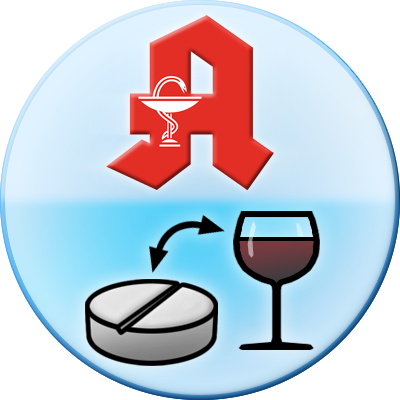The German ABDA Drug Interactions Database in a nutshell
This database lists interactions among German drugs, substances and foodation stored in the Drug Interactions Database. It provides the following information:
- Effect
- Mechanismen
- Activities to avoid interaction
- Note on special characteristics of interaction
To identify potential drug-drug interactions and risks due to individual patient characteristics – such as age, gender, history – appropriate data are useful for reviewing the medication. With the ABDA Database Interaction module and the CAVE data module, pharmazie.com provides basic data for an database -based review of individual drug risks.
Suitable for:
Pharma Industry, Health Insurance, Regulatory
Source: ABDATA PHARMA-DATA-SERVICE
Eschborn, Germany
Related subscription
This database can be accessed after purchasing the subscription package ‘Drug Dictionaries’, ‘Drug Pricing’ or ‘Premium’
What customers say
The use of the ABDA database CAVE and the ABDA database Interactions is very valuable for teaching at the Pharmacological Institute because there is no other complete directory of all drugs approved in Germany. There is also no other program as good and reliable as the Cave and Interaction modules for testing for interactions, which we regularly use as part of the course tasks.
Background information
General info
Interaction of drugs with each other and between drugs and food and addictive substances is included in this interaction module.
OTC medicines and herbal medicines are of course included. Nutritional supplements are also considered if they can cause interactions because of their ingredients and their dosage.
Decisive for the inclusion of an interaction in the module is the expected risk to the patient: A monograph is created for interactions that may be clinically relevant.
Content and structure of the monographs
PHARMACOLOGICAL EFFECT indicates the symptoms that can cause the patient’s interaction.
The MECHANISM section explains the (presumed) mechanism of interaction.
ACTION suggests how the interaction can be handled. Parameters are given to be monitored and used to adjust the dosages. For some interactions, the time-delayed intake is sufficient. If this makes sense, alternative drugs or therapies are recommended.
The COMMENT lists clinical trial results and other information that help to assess the frequency, extent and importance of the interaction. It also identifies risk factors that predispose certain patients to interaction (eg, renal insufficiency, elderly, children, parenterally nourished patients). If applicable, the cases in which the interacting drugs may be deliberately used together may be mentioned.
Finally, the LITERATURE, which was evaluated for the monograph in question, is cited.
Quick information
- Title: Interacting groups of substances or substances. In the title, groups of substances are used as names, if useful and possible, e.g. ACE inhibitors. If only one substance is definitely affected, it is named, e.g. bromocriptine, allopurinol.
- Brief description of the effect: When describing the effect, the symptoms that may occur in the case of interaction are briefly mentioned.
- Classification: The interaction is classified according to the required measures.
Example:
|
Halcion 0.25 mg Tablets PFIZER >< Invirase 500 mg Film-coated tablets ROCHE
|
|
| Title: | Midazolam, Triazolam >< HIV protease inhibitors |
| Effect: | increased or prolonged sedation, respiratory depression |
| Clinical significance: | Serious consequences probable – contraindicated |
| Pharmacokine. Mechanism: | Inhibited oxidative metabolism. |
Clinical significance of interaction
ABDATA has developed a classification system that corresponds to European conditions: The interaction monographs of the Drug Interactions Database are classified according to the required measures. This classification should enable users to quickly identify which measures must be taken in individual cases in order to avoid interaction. Already the first display on the screen gives appropriate hints.
Monograph texts
The quick information alone is not sufficient to inform oneself sufficiently about an interaction. Only with the detailed monograph text an interaction can be estimated in its meaning for a certain patient!
Example monograph:
Halcion 0.25 mg tablets PFIZER >< Invirase 500 mg film-coated tablets ROCHE
Pharmacological effect: Here symptoms for the interaction in the patient are mentioned: “Simultaneous treatment with HIV protease inhibitors can increase the effects of perorally applied midazolam and triazolam; strong, prolonged sedation and respiratory depression cannot be ruled out”.
Mechanism:The mechanism of interaction is explained.
“HIV protease inhibitors can inhibit the biotransformation of triazolam and midazolam by CYP3A4. In midazolam, the peroral application is more affected because it has a high first-pass effect, which is impaired by enzyme inhibition: Bioavailability increases many times over”.
Measures:Here it is suggested how the interaction can be handled. Parameters are given that are to be monitored and that can be used to adjust the dosages. For some interactions, the delayed intake is sufficient. In addition, alternative drugs or therapeutic options are recommended:
“Peroral midazolam and triazolam are contraindicated during therapy with HIV protease inhibitors. Depending on the indication, oxazepam, lorazepam, lormetazepam and temazepam, which are metabolized by conjugation with glucuronic acid, may be considered as alternative benzodiazepines. Special care should also be taken when using midazolam parenterally (see benzodiazepines – HIV protease inhibitors).”
These are recommendations. The measures to be taken in individual cases must be individually tailored to the patient. For example, for each alternative drug it must be checked whether it is contraindicated in the patient.
Comment:This section provides clinical trial results and other information to help assess the frequency, extent and importance of interaction. These include, in particular, risk factors that particularly predispose certain patients to interaction (e.g., renal insufficiency, elderly patients, children, parenterally fed patients). In addition, the cases in which the interacting drugs are deliberately used together are mentioned here:
“The respiratory depressive effects of benzodiazepines in patients with respiratory diseases are more pronounced.”
Substance part
The interactions are usually described at the substance group level (e.g. beta-blockers, H2-blockers, neuroleptics). Only if only one substance is actually affected is it mentioned in the title of the monograph. The advantage of the description at category level is that all substances in a category can be evaluated with regard to their interaction.
The substances concerned are classified under four headings:
Example monograph:
Halcion 0.25 mg tablets PFIZER >< Invirase 500 mg film-coated tablets ROCHE
Interaction described
For these drugs the interaction is described in detail in clinical studies or case reports. All substances for which the interaction is described are listed.
This category is not documented in the example monograph.
Interaction expected
The substances of a substance group for which the interaction must be expected due to the mechanism of action or pharmacokinetics are listed here. Only substances for which finished medicinal products are on the market in Germany, Austria and Switzerland are listed. In the example monograph:
| Midazolam, Triazolam | HIV protease inhibitors |
| Midazolam | Atazanavir |
| Triazolam |
Darunavir Fosamprenavir Indinavir Lopinavir Ritonavir Saquinavir Tipranavir |
Literature: The literature evaluated for the monograph in question is cited:
|
Eichbaum, C. et al. |
69, 1795-1800 (2013) |
Eur. J. Clin. Pharmacol. |
|
Fachinformation Aptivus® |
(2016) |
Boehringer Ingelheim International GmbH |
|
Fachinformation Dormicum® |
(2017) |
Roche Pharma AG |
|
Fachinformation Halcion® |
(2017) |
Pfizer Pharma PFE GmbH |
|
Fachinformation Invirase® |
(2016) |
Roche Registration Ltd. |
|
Fachinformation Reyataz® |
(2017) |
Bristol-Myers Squibb Pharma EEIG |
|
Greenblatt, D.J. et al. |
19, 293-296 (1999) |
J. Clin. Psychopharmacol. |
|
Greenblatt, D.J. et al. |
24, 129-136 (2000) |
J. Acquir. Immune Defic. Syndr. |
|
Greenblatt, D.J. et al. |
68, 920-927 (2009) |
Br. J. Clin. Pharmacol. |
|
Palkama, V.J. et al. |
66, 33-39 (1999) |
Clin. Pharmacol. Ther. |
|
Schmitt, C. et al. |
29, 1175-1181 (2009) |
Pharmacotherapy |
In each monograph the status of the last update is indicated (here: 01.05.2018).
On first view quick information
The German Drug Interactions ABDA Database lists e.g.:
Title: The affected substance groups are used as names. If only one substance is definitely affected, it will be named in the title.
Brief description of the effect: Symptoms of the interaction in short form.
Classification of clinical significance: The interaction is classified according to the required measures.
Already the first display on the screen indicates the necessary measures:
- Serious consequences likely – contraindicated
- Serious consequences are likely – contraindicated in certain cases
- Serious consequences possible – as a precaution contraindicated
- Simultaneous application not recommended
- Monitoring or adaptation necessary
- In certain cases, monitoring or adaptation necessary
- Monitor as a precaution
- In general, no action required
The quick information allows a brief overview, but only with the detailed monograph text an interaction in their importance for a particular patient can be estimated.
Selection criteria
Interactions between medicinal products and between medicinal products and food and stimulants are recorded in the Drug Interactions Database. OTC drugs and phytopharmaceuticals are of course included. Medical devices and dietary supplements are also included if they can cause interactions due to their ingredients and dosage.
Not taken into account in the Drug Interactions Database:
- Incompatibilities: Chemical incompatibilities in vitro.
- Food effects: This is an absorption effect caused by macro nutrients such as proteins, fats and carbohydrates. Information on these can be found in the module Active Substance Dossiers under Food Interactions.
- Contraindications: Sometimes it can be concluded from the indication of a prescribed drug that there is a contraindication for another drug: e.g. the use of a proton pump blocker such as Pantoprazole suggests a gastric ulcer. Acetylsalicylic acid would then be contraindicated. However, this is not an interaction.
The decisive factor for the initiation of an interaction is the expected risk for the patient: A monograph is prepared for interactions that may be clinically relevant. This is the case when
- the interaction may occur during normal use of the medicinal products, and
- it is expected that the interaction will alter the efficacy/toxicity of a drug to an extent that requires action (e.g. no concomitant administration, dose adjustments, laboratory controls, intensive observation).
Selection is subject to change as scientific knowledge, assessments and treatment habits evolve.
The interactions listed in the instructions for use and in the specialist information cannot be mapped congruently in the Drug Interactions Database because the data on identically composed drugs often do not coincide. In addition, an interaction can be indicated in the technical information of one interaction partner, but not in the technical information of the other interaction partner.
These databases could also be interesting for you
Related posts
Find German Equivalent of US Drugs – A Guide for Pharma Professionals
Find German equivalent of US drugs – it’s a challenge that pharmacists, healthcare providers, and pharmaceutical analysts often face. A patient arrives with a U.S.-branded prescription, or a formulary review requires checking if an American medication is available in...
AMNOG Reimbursement Database Europe – Unlocking Pricing & Access Data for DACH Markets
In the pharmaceutical industry, having timely and accurate reimbursement data is crucial for successful market access across Europe. Especially in Germany, Austria, and Switzerland (DACH), you face a patchwork of pricing systems and databases. Navigating these can be...
Drug Shortage Database Germany – A Comprehensive Solution to Medicine Supply Gaps
Germany has been grappling with increasing medicine shortages in recent years. Ensuring a reliable drug shortage database in Germany is crucial for healthcare stakeholders to maintain patient care and plan effectively. Official figures show that medicine supply issues...






